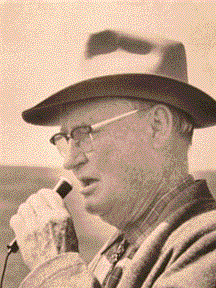 1907-1990
1907-1990
Ken Wagnon was born in Douglas, Arizona Territory in 1907. He and his parents moved to a farm near Sebastopol, California, in 1921. He attended the University Farm at Davis from 1928 to 1933, receiving a BS in Animal Husbandry from UC Berkeley in 1932 and doing graduate work in Nutrition and Genetics. During this time he worked several part-time jobs in the Animal Husbandry Department and in the Veterinary Division.
Ken was hired as an Assistant Animal Husbandman in the Department of Animal Husbandry on November 4, 1935. He was stationed at the San Joaquin Range Station at O'Neal where he conducted research on beef cattle and range improvement for twenty-three years. He spent an additional twelve years at the Sierra Foothill Field Station near Brown's Valley.
He was a hands-on researcher, following and observing cattle 'round the clock. He would measure the time a cow spent fighting heel flies, and how far she'd run to try to get away from them and come up with a measure of lost productivity. Probably no-one in the world has been as thorough as Ken in studying the grazing habits of range cattle. Another area of his research was the effects of certain forages on birth defects. He studied acorn calves. He was widely known for his accurate research and his integrity was highly respected in the scientific arena.
Ken was a prolific writer, having published technical, as well as scientific, bulletins, leaflets, and articles for Journal of Animal Science, as well as the textbook Beef Cattle Production, co-authored with Rube Albaugh and George Hart. One article he wished he'd taken credit for was "Two Blades of Grass Where Thousands Grew Before" which he ghost wrote for John O'Neal. This was a pro control-burning, anti Forest Service polemic that was published in Western Livestock Journal in the Spring of 1953.
He was chairman of the Staff of the Davis Division of Agricultural Sciences from 1966 to 1967. He was the acting superintendant of the Sierra Foothill Field Station from 1961 to 1964.
After Ken retired in 1972 he pursued an interest in his family history and continued to assist with research projects until he moved to Albuquerque, New Mexico, in 1983.
